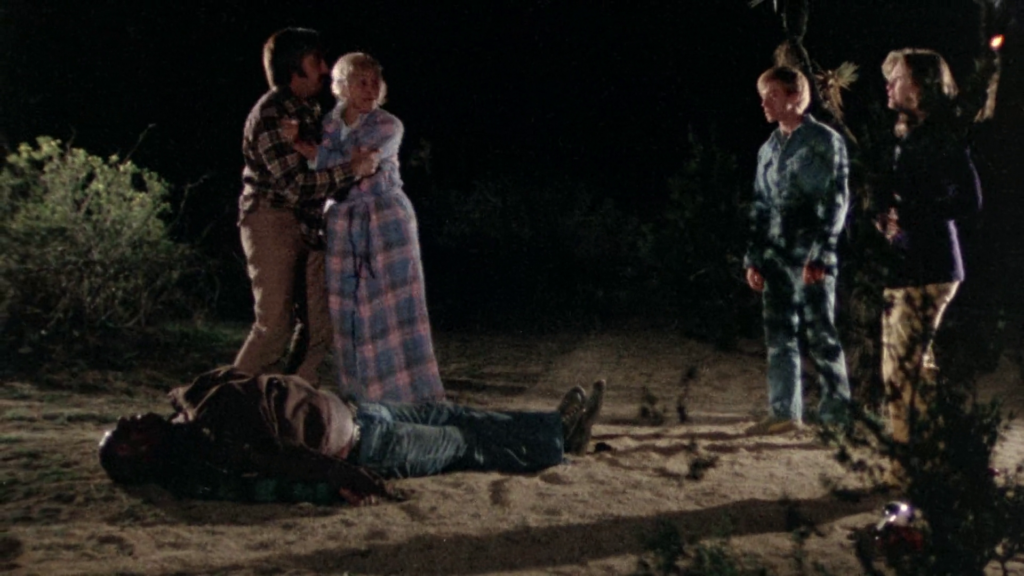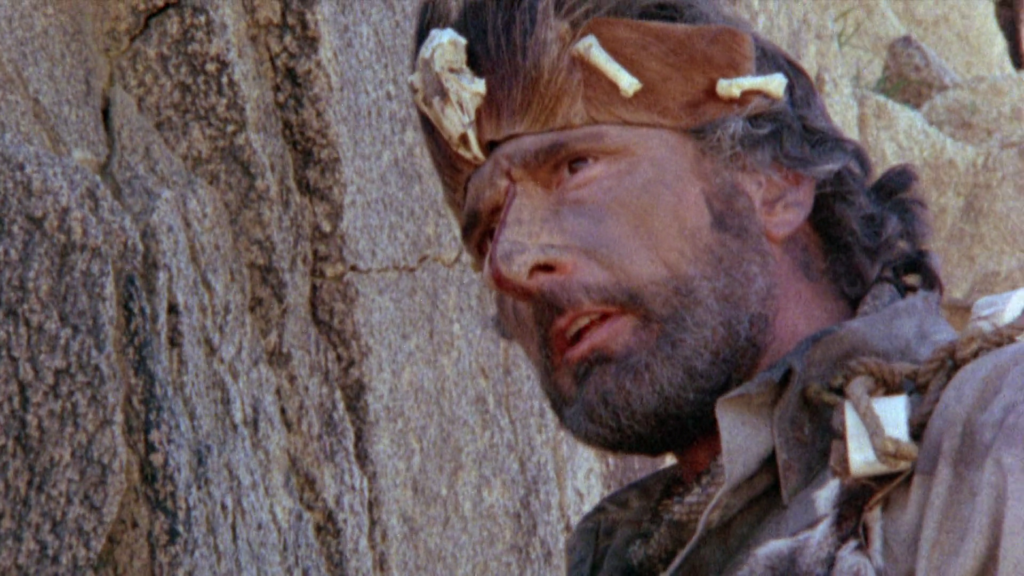Friday the 13th (1980)
“Camp Crystal Lake is jinxed.”
|
Synopsis: |
|
Genres, Themes, Actors, and Directors:
Response to Peary’s Review: Redeeming Qualities and Moments: Must See? Categories
Links: |
“Camp Crystal Lake is jinxed.”
|
Synopsis: |
|
Genres, Themes, Actors, and Directors:
Response to Peary’s Review: Redeeming Qualities and Moments: Must See? Categories
Links: |
“I’m going to get those bastards.”
|
Synopsis: |
|
Genres, Themes, Actors, and Directors:
Response to Peary’s Review: … and Dee Wallace in one of her first feature-length film roles. Other noteworthy performances include Houston as a back-flipping teenager who suddenly finds himself at the head of a posse for survival: … and Blythe as the only sympathetic cannibal. Redeeming Qualities and Moments:  
Must See? (Listed in 1001 Movies You Must See Before You Die) Links: |
“Are you sure we’re not going to put you folks to any trouble?”
|
Synopsis: |
|
Genres, Themes, Actors, and Directors:
Response to Peary’s Review: … but quickly devolves into a middle section that’s “an outright embarrassment” and a “final section” that’s “hogwash”. He accurately notes that the “humor [and] happy music are offensive”, that “you’ll feel ashamed to be watching it”, and (presuming you’re seeing it in a theater) you’ll “feel paranoid about the men around you who are grinning and taking delight in the girls’ torture.” He argues that the “major problem is that the film is so convincingly made — and the sadists and their victims so authentic — that the torture scenes really seem to be happening.” Remarkably (or, sadly, not so), the film has a significant cult following and was recently released on Blu-Ray. Regardless, as DVD Savant writes, “it’s still an indefensible carnival of cruelty and carnage, with unendurable pain and suffering meted out to two innocent girls by a quartet of pitiless human monsters.” Meanwhile, Howard Thompson’s review for The New York Times is worth copying here in its (short) entirety:
Redeeming Qualities and Moments: Must See? Links: |
“What could be wrong with our child? We’re beautiful people, aren’t we?”
|
Synopsis: |
|
Genres, Themes, Actors, and Directors:
Response to Peary’s Review: … and Peck’s eventual realization that he will have to take unthinkably drastic actions. Of special note is Billie Whitelaw as Damien’s nanny; she steals the show each moment she’s on screen. Redeeming Qualities and Moments:
Must See? Links: |
“You like games? So do I.”
|
Synopsis: |
|
Genres, Themes, Actors, and Directors:
Response to Peary’s Review: He adds that the film’s “premise is intriguing but disturbing — it’s tasteless enough seeing movie heroines raped by monsters in some recent pictures, but Christie being molested by a mechanical apparatus is ludicrous and appalling…” With that said, he notes that “Christie’s about the only actress who could retain her dignity playing such a victim”, and indeed “gives one of her finest, most vulnerable performances”. Peary writes that while “the film’s cultists don’t like the ending”, he finds “it to be satisfying”, and notes that the “scariest scene, other than the rape of Christie, is when Proteus attacks scientist Gerrit Graham”. While Demon Seed is undeniably cliched, illogical, and silly in many ways, it remains surprisingly suspenseful and relevant to our modern times, when “personal devices” control far more of our existence than they (very likely) should, and we’re equally — or more — at risk of AI surpassing our own ability to control what we’ve created. If you’re curious, watch this fun 10-minute overview of the film. (YouTube has added a whole new dimension of possibilities to film blogging!) Redeeming Qualities and Moments: Must See? Links: |
“I’m telling you that thing upstairs isn’t my daughter.”
|
Synopsis: |
|
Genres, Themes, Actors, and Directors:
Response to Peary’s Review: Peary notes that the “special effects make-up by Dick Smith and Rick Baker revolutionized the horror genre”, leading one to “feel sorry for Blair.” (She has since acknowledged it was “grueling” to go through being made-up for two hours each day — and we’ve also learned she fractured her back during the scene in which she’s bounced violently up and down off her bed.) Peary refers to Friedkin’s direction simply as “solid”, noting he likes “the way he refrigerated Blair’s room so that steam pours out of everyone’s mouth”, and he asserts that the “most interesting aspect of the picture is that it conveys a fear that is rarely dealt with: Regan doesn’t have those around her turn into monsters (a basic primal fear) but becomes a monster herself. Not since Pinocchio grew donkey ears and a tail has a child become so bestial.” Peary argues that the “caliber of acting and production gave the film needed class to attract a mass audience” — but this understates the fact that The Exorcist had a tremendous cultural impact. Documentary footage reveals that audience members waited in line for hours to see the film, and would routinely leave and/or faint mid-way, unable to continue their viewing. Despite costing twice as much as its initial budget (and taking twice as long to film as projected), it remains the ninth highest grossing film of all time (adjusted for inflation). Viewed on its own terms today (almost 50 years later), The Exorcist has held up remarkably well: for better or for worse, Friedkin’s draconian directorial style (doing whatever he deemed necessary to get the responses he wanted from his actors and set) resulted in a film which authentically represents humanity at its most vulnerable and terrorized. This is not a film to watch or take lightly — and while modern-day audiences may be less astonished by the impressive special effects (all achieved on-set, rather than altered during post-production), they remain truly noteworthy and frightening. Redeeming Qualities and Moments:
Must See? Categories
(Listed in 1001 Movies You Must See Before You Die) Links: |
“It knows what scares you. It has from the very beginning.”
|
Synopsis: |
|
Genres, Themes, Actors, and Directors:
Response to Peary’s Review: But he argues that “what makes [the] film really nerve-wracking — especially if you’re a young viewer — is that every thing (trees, dolls, toys, records, furniture) comes to life and becomes hostile.” He adds that the “characters are appealing” (though he complains that “Dunne’s character has nothing to do”): … and posits that the “finale, which is too much like the end of The Amityville Horror, is anticlimactic — all the skeletons, the mud, and the loud screaming are annoying.” I’m of two minds about Poltergeist, which I never saw as a kid or teen (I was horror-averse until my adulthood, when I could finally approach the genre from a sufficiently analytical lens and avoid sensory overload). While I recognize its innovation in terms of special effects and numerous thrilling moments, I find the storyline and characters frustratingly inconsistent. (To name just two glaring errors, Nelson has purportedly missed days of work while his younger daughter is missing — without the police being notified? And distraught Williams apologizes to Straight for inconveniencing her?!) Some have argued for “hidden depths” in the film, finding meaning and nuance in each narrative or visual twist, while others have semi-jokingly pointed out “everything wrong” with the movie. Ultimately, film fanatics will need to decide for themselves whether this becomes a beloved favorite or a once-and-done cult flick with historical significance. Redeeming Qualities and Moments: Must See? Categories
(Listed in 1001 Movies You Must See Before You Die) Links: |
“One of the great things about my life is that I haven’t the faintest idea what I’m gonna be doing in a year’s time.”
|
Synopsis: |
|
Genres, Themes, Actors, and Directors:
Review: Redeeming Qualities and Moments: Must See? Links: |
“Let’s spent the night together / Now I need you more than ever.”
|
Synopsis: |
|
Genres, Themes, Actors, and Directors:
Response to Peary’s Review: He argues that “the camera seems incapable of achieving any intimacy with the performers”, and that “even Mick Jagger seems distant”. Indeed, I was surprised and dismayed to see what a lost opportunity this film is, given the possibility of concert films not only to not only give viewers an up-close view of their favorite performers in action, but to show behind-the-scenes interactions leading to or following the event. We don’t hear any dialogue here, and the few cutaways to non-performance footage are oddly interspersed. The one semi-cool scene shows a concert stadium being set up for the evening’s show in time-lapse: As Peary notes at the end of his very brief review, “You’ll have better luck with Gimme Shelter” (I agree). Redeeming Qualities and Moments: Must See? Links: |
“My body can’t take this treatment anymore. The blood of these whores is killing me!”
|
Synopsis: |
|
Genres, Themes, Actors, and Directors:
Response to Peary’s Review: Peary calls out Juerging’s “bar-game scene with peasant Roman Polanski” as “also a highlight”. I agree with Peary that this cult favorite is well worth a look: it’s sumptuously filmed, cleverly scripted, and offers plenty of atmospheric, tongue-in-cheek enjoyment. Chances are you’ll enjoy it more than you expected to. Redeeming Qualities and Moments:
Must See? Categories
Links: |